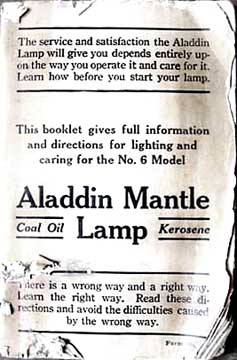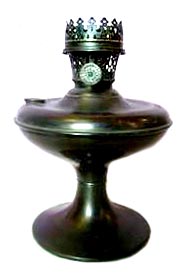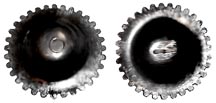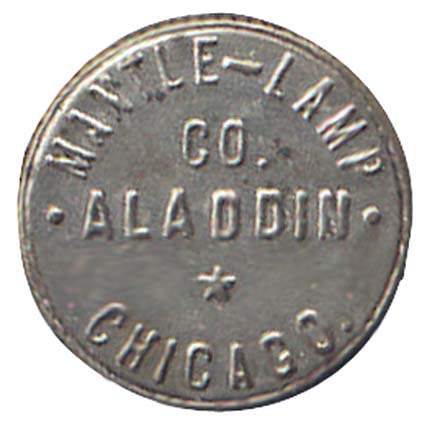![]()
![]() Contents > Illustrated
dictionary
of Aladdin lamp terms
Contents > Illustrated
dictionary
of Aladdin lamp terms

|
A Dictionary of Aladdin Lamp TermsThere are a lot of terms thrown about by Aladdin Lamp collectors and specialized names for different lamp parts. Hopefully this lexicon page will enlighten you. When collecting the model A and B glass lamps you will come across a myriad of names such as Washington drape, Corinthian, Quilt and Majestic. These names are agreed upon collector given names that help people identify the different styles. They are a completely non Aladdin artificial classification system used to bring order to approximately 100 Aladdin catalogue numbers. Aladdin used a different catalogue number to identify each colour of each glass lamp version. For instance an Aladdin B-91 is a glass lamp with a white translucent diamond cross hatch pattern bowl and a ribbed rose coloured glass foot. A B-92 is green glass lamp with matching vertical ribbing on both the bowl and stem. Memorizing about 20 class names is a whole lot easier than memorizing descriptions to each of 100 or so catalogue numbers. I have not addressed model B collector names in this lexicon. Since my primary focus is on the metal lamps and on burners, I only have a few glass models addressed elsewhere in this site. If you get serious about collecting Aladdin glass lamps your first and best tool is always Courter's book.
Air Distributor - This is a screen that fits at the top of the burner around the outer wick tube. This regulates the air flow feeding the outside of the wick. The air distributor was a separate screen on models 1 through 6 and became an integral part of the outer wick tube on models 7 and newer.
Alacite - A ivory coloured opal glass developed in 1938 to make lamp bowls. The original formula used uranium oxide to achieve its colour. The government banned the use of uranium oxide in 1942 as part of the war effort. The colour of Alacite varied in the new formula from yellow ivory to pink ivory. Lamps made from the original formula will fluoresce under a black light. Alpha Art Glass - Aladdin marketing term for clear soda-lime glass used to make Model A lamp fonts. Colours were painted onto the clear glass. Term used in the early thirties. Art Glass - Aladdin marketing term for clear or tinted soda-lime glass. Term used by marketing from late forties through present.
Beta Crystal glass - Aladdin marketing term for transparent or coloured soda-lime glass used to make vase lamps, lamp fonts and glass shades Term used in the mid thirties through mid and late 1940's. Bottom plate - see drip plate Boudoir lamps - Aladdin UK painted some model 14 and newer lamp fonts (not the burner) with a warn cream colour and marketed them as boudoir table lamps. Bug Screen - A roofed cylindrical screen placed over the top of the chimney to keep bugs that are attracted by light from diving into the chimney and damaging the lamp mantle. Aladdin changed the name to insect screen in 1943. The earliest mention of a bug screen that I have seen has been 1917. The original style bug screen was replaced around 1928 with a newer style that had a circle of fingers pointing downwards. The currently available insect screen was introduced in 1949 along with the 'made in Nashville' model B burners. In 2004 Aladdin introduced an insect screen that is very similar to the style introduced in 1928. If you try to match bug screens to lamps, my current guess is that models 1 through most of model 6 (insulated undated burner and dated burners) did not have one available. Late model 6 (undated and uninsulated burner), along with models 7 through 11 used the original style bug screen, model 12 and Model B with Chicago burners used the insect screen (first called bug screen then insect screen). Model B with Nashville burners and newer use the current production insect screen. Burner base - This is a stripped down burner that is left after all the parts that can be removed without tools have been removed.
Ceiling extension (pull down) - See extension Centre draft or drought - A style of lamp and burner that draws air from holes at the base of the lamp up through a draft tube at the centre of the lamp, through the flame spreader to the inner edge of the wick. Models 1 through 12 are centre drought lamps. The air flow through the draft tube increases as the burner temperatures increase causing the flame to burn brighter. Centre drought lamps require close attention until the temperature reaches equilibrium. Chimes: The fold that connects the top half of a metal lamp
bowl to the lower half.
Chimney - Aladdin lamps use special tall narrow chimneys designed specifically to work with Aladdin lamps. The chimney has two primary functions: it forms an undisturbed vertical pathway to draw heated air out, pulling fresh air to the burner and it keeps breezes from affecting the flame. There are three basic types of chimney. The standard Aladdin chimney is 12-1/2 inches tall and the base is either "heelless" (models #1 through 11 and 23A) or "Lox-On" (Models #12 through 23). There was a longer "high altitude" version of the Lox-On chimney that provides additional draw for the thinner atmosphere of higher altitudes. Drip tray - Also known as a bottom plate. This is the plate that fits to the base of centre draft font lamps. This would keep any flaming object from falling down through the centre draft tube and landing on something flammable below. Drip trays used from model 1 through very early model 6 had threads in the centre of the plate suitable for mounting the font lamp. Only the models 3 & 4 took advantage of these threads for mounting lamps. In this web site I refer to drip trays as bottom plates.
Extension - (ceiling extension or pull down)This is a device that hangs from the ceiling that allows a hanging lamp to be pulled down for lighting, extinguishing or refilling. The extension body covers a spring loaded drum that holds chain. Extensions were offered as an option for hanging lamps. Aladdin offered ceiling extensions until around 1950 (I suspect they were discontinued at the time Aladdin moved offices from Chicago to Nashville in 1949).
Flame spreader - First known as a Generator. The name was changed in 1928 between the model 11 and model 12 production to avoid customer confusion with a gas lamp generator. Only model 6 and 11 flame spreaders made for the replacement parts market after 1927 bore the name 'flame spreader' embossed on the top. Thimble style flame spreaders that originally came on pre model 12 lamps from the factory had 'generator' embossed on the top. Model 6 and the taller model 11 flame spreaders were kept in production into 1954 to serve as replacements for model 3 through 11 lamps. See generator for pictures. Font - This is the name of the lamp body used for hanging and wall bracket lamps. Without the mounting bracket, the complete lamp with burner is called a' font lamp'. Mounted, it is called a hanging or wall bracket lamp.
Gallery - The gallery fits onto the top of the burner and holds both the mantel and the chimney in place. You remove the gallery to light the lamp. There are several versions of the gallery. The earliest version (Models 1 and 2) fit the cap mantle and a heelless chimney. Models 3 through 11 used gallery variations that fit the KoneKap mantle and a heelless chimney. Models 12 through 23 used gallery variations that fit the Lox-on mantle and Lox-On chimney. Model 23A fits the Lox-on mantle and heelless chimney.
Generator - Later known as a Flame spreader starting in 1928, fits to the top end of the inner wick tube and meters air to the burning wick. All but the first generator has tiny holes along the top edge that directs metered (by the hole size) air evenly along the inner base of the wick. This injection of air into the centre of the burning circular wick spreads out the flame towards the base of the mantle . The fresh air coming into the centre of the flame also reduces any tendency for the wick to produce smoke and soot. The first four lamp models each saw dramatic changes in the generator shape. The model 4 generator with it's thimble shape worked well enough for Aladdin to retain the basic shape in later lamps. Basically the only things that changed between models 4 and 11 were the length, air hole placement and the labeling. Model 12 saw the flat top changed to an inverted cone with a single hole in the bottom centre. This model 12 design is in use today and is correctly called a flame spreader. See Flame Spreader for additional information.
Harp - This is the fame assembly for a hanging lamp without the font lamp installed.
Inner wick tube - The wick is held in place between the inner and outer wick tubes. On model 1 through 6 the inner wick tube is an integral part of the lamp font. On model 7 through 12 lamps there were two inner wick tubes. The lower tube is integral to the lamp font and the upper inner wick tube is integral to the burner base. The side drought burners, model B and newer have a short inner wick tube integral with the burner. The lamp font has no inner wick tube. The flame spreader fits inside the top of the inner wick tube. On centre drought lamps the inner wick tube is also known as the centre drought tube. Insect Screen - A screen placed over the top of the chimney to keep bugs that are attracted by light from diving into the chimney and damaging the lamp mantle. Before 1943 Aladdin called insect screens "bug screens". See "bug screen" for additional information.
JAP Bronze - Oxidized copper finish optional on parlor lamps, most model 12 versions, the model B oriental and treasure lamps. The lamp was first copper plated then dipped into an oxidizing solution to achieve the finish. A coat of clear lacquer was added for finish protection. The end colour depended upon how long the lamp was left in the oxidizing solution. Model 12 bronze is darker than model B bronze. Aladdin offered a bronze finish on some 1949 and later model B lamps that is a paint colour.
Lox-On Chimney - An Aladdin chimney with two small locking flanges formed at its base. This chimney works with the model 12 through 23 galleries.
Match holder - Aladdin provided a wall mount match holder with each model 5 (1913) through 11 lamp sold. The match holder was made of copper plated tin and had pockets for holding, a spare generator, a wick cleaner, an instruction book and of course matches. There are two versions of the holder. One without the Aladdin name and one with the name in script. The one without the name appears to have been sold during 1914 with model 5 and early model 6 lamps. The version with the script would be 1915 model year and newer.
Mantle - This is a thin filament net that becomes incandescent when heated emitting a bright whitish light. This is what generates the legendary bright Aladdin light. The flame at the wick only serves to heat the mantle into incandescence. There are three major variations of the mantle. The first is a Cap mantle with a single support arm. This was a European design and was used on early model 1 lamps. Later model 1 and model 2 lamps were supplied with a double armed Cap mantle. The cap mantle was not made by Aladdin and they had no control over manufacturing. Starting with the model 3 lamp through the model 11 an improved KoneKap mantle has been used. The KoneKap mantles incorporates the cone that had been part of the gallery and has a more precision mounting system assuring a more standardized space relationship between the mantle and the flame. The Kone Kap mantle, model 3 gallery and flame spreader were Aladdin patents and brought full manufacturing, quality and sales control to Aladdin. Welsbach manufactured a line of KoneKap mantles for P&A manufactured mantle lamps. The third type of mantle is the Lox-on mantle which was introduced with the model 12 lamps and is still used today on new Aladdin lamps. Both KoneKap and Lox-on mantles are available through Aladdin today. Moonstone glass - A misty translucent alabaster glass used to make lamp fonts.
Nashville Burner - In 1949 Aladdin moved it's headquarters from Chicago to Nashville Tennessee. Burners manufactured prior to that date in the US for the North American market were marked Chicago. Model B burners made from 1949 through 1954 were marked 'made in Nashville Of course the burners were all made in Connecticut at the Plume & Atwood factory and not in Chicago nor Nashville Also during during this period model 12 burners were still in limited production for the replacement parts market. These model 12 burners were marked' made in Nashville Nashville burners are only original on model B lamps manufactured 1949 and later. During 1949 there was a metal lamp manufactured that used the lamp bowl from the model B Treasure lamp and a model 12 foot. It also had a model B burner marked Nashville This single year production lamp is known as the Nashville Treasure.
Oil Pot - A specialized type of font lamp designed to sit inside a lamp base and only be exposed for viewing at the top flange and above. Centre draft round wick lamps burn brighter than flat wick lamps. The oil pot allowed centre draft round wick lamps to be used with glass lamps. This is the construction of the often elaborate 'gone with the wind' style lamps. Oil pots were also used with some hanging, piano and floor lamps. There seemed to be numerous companies during the late 1800's and early 1900's engaged in making glass and formed metal lamps that used oil pots purchased from other companies. There was an industry standard oil pot size and oil pots were interchangeable between lamps. Model 1 through 6 Aladdin oil pots were marketed as lighting upgrades for existing lamps that used oil pots. The model 6 oil pot was used in Aladdin's first floor lamp. The oil pot font used in Aladdin models 1 through 6 oil pot lamps is a generic off the shelf P&A design that had been in production from the late 1800's. This oil pot font was not retooled for the larger base model 7 burner and production of Aladdin oil pots ceased. By 1930, Aladdin had it's own glass division and decided to have Plume & Atwood tool up a model 12 oil pot to produce vase lamps. Aladdin produced a nonstandard size model B oil pot for the very first model B floor lamps. This was in production through 1934 and represents the last of the special made Aladdin oil pots. The model 23 majestic lamp uses a standard #23 font lamp as an oil pot. Old English - An "old gold" colour finish applied to some early Aladdin Lamps. Outer wick tube - The wick is held in place between the inner and outer wick tubes. On model 1 through 6 the outer wick tube is an integral part of the burner base. On model 7 and newer burners the outer wick tube is removable and has the air distributor as an integral part.
Rose Gold - A gold coloured zinc copper alloy plating used on some model B lamps
Satin Brass - A scratched finish applied by a fine brass wheel then covered with a clear lacquer. Used on some early lamps Sauerisen cement - The original glue used to hold parts for glass lamps together. It is a white substance. One of the major ingredients is plaster. Side Draft or Side Drought - A type of burner that draws all the air used for the wick from the holes on the side of the burner base. This is also known as an "Instant on" burner because the warm up time is considerably faster than a centre drought burner. Aladdin model A and newer burners are all side drought. Silcrom - A deep smoky chrome appearing finish used by Aladdin UK on some model 21 and newer lamps as a cost reduced finish. It was used on both burners and lamp fonts. I don't believe the finish was ever offered to non-UK markets. Smoke Bell - A shallow cone shaped part that is suspended a couple inches above the chimney on a hanging lamp. The purpose is to break up the hot air flow and dissipate it before it reaches the ceiling. An Aladdin hanging lamp used without a smoke bell could heat a ceiling to the point that it will burst into flame.
Wick - A cotton tube split in half about 1/2 of its length. The wick transports kerosene from the bowl to the top of the burner. Starting in 1919 Aladdin started manufacturing their own wicks. Aladdin wicks last a very long time with proper care and if fresh high grade uncoloured, unscented kerosene is used. Colouring and scenting agents can clog a wick over time. Wick adjuster knob - This is the disk like knob used to adjust the height of the wick in a lamp. This is what most people use to identify the model of Aladdin lamp. The only differences among the models 9, 10 and 11 burners seem to be the label on the wick raiser knob and the flame spreader. At the other extreme, models 1, 2, 2-3 transition and 4 share the same wick raiser knob.
Wick Cleaner- Aladdin started providing wick cleaners with each lamp around model 4 and continues to do so today. Over the years Aladdin has provided at least 30 different varieties of wick cleaner including at least of 4 of the newer plastic style. Wick cleaners are used to clean carbon deposits off the top burning edge of the wick so that the wick will burn with a more even flame. The newer cleaners work better than the early types. Three prong wick cleaners were used through model 8. Steel wick cleaners were used during WWII. Brass wick cleaners were used again after WWII on model B and C lamps until model 21C was introduced. Since then the wick cleaner has been plastic. Collecting wick cleaners can easily become a Aladdin lamp sub hobby.
Wick Holder - A metal tube attached to the lamp wick that is moved up and down by the wick riser in the burner base. Wick holders were used with unreinforced wicks in lamp models 1 through 9 (first year of production). Around the beginning of the model 10 production (second year of model 9 production) a reinforced wick was introduced. This wick came with two metal buttons on the side that connected the reinforced wicks directly to the wick raiser without the use of a wick holder. On models 1 through 7 the wick holder was also the wick riser.
Wick raiser - Wick raisers were introduced with the model 8 lamp and have been part of different burner designs through the current burner. The model 8 and early 9 wick raiser attached to a short wick holder. With the introduction of the reinforced wick, the wick raiser attached directly to the two metal side tabs of the wick and completely eliminated the separate wick holder.
Whip-o-lite - The trademarked name for a style of translucent paper developed and used by Aladdin to make paper shades. It stands up to heat and is evidently washable.
|
||||||||||||||||||||||||||
| If you would like to discuss any of the contents please feel free to . © 2002, 2015 by TeriAnn
Wakeman. All rights reserved.
|


 Smoke
bell used with model 1 through early 6 hanging lamps
Smoke
bell used with model 1 through early 6 hanging lamps
